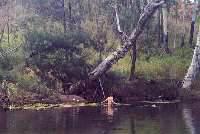 Field Collecting Australian Waterlilies
Field Collecting Australian Waterlilies
Expedition 2002
By Andre Leu - Photos by Julia Leu
Click images to enlarge
Because I believe that the water lilies collected near Normanton
on my 2000 expedition with Walter Pagels will prove to be a new
species of the Australian subgenus Anecphya, I revisited
the area in late March of 2002. Normanton is near the border
of Queensland and the Northern Territory and close to the Gulf
of Carpenteria.
To reach Normanton from my home in the vicinity of Mossman on Queensland's east coast, my wife Julia and I retraced the route Walter and I took in 2000 in hopes of finding the population of high altitude N. immutabilis that I had seen in past years. We crossed the Atherton Tablelands to Ravenshoe, Queensland's highest town set at over 3000 feet. Although in the tropics, Ravenshoe gets winter frosts. In 2000, due to the unusually heavy monsoon season, the constant flooding of the river systems meant that there were no lilies to be found.
This time I managed to locate them and collected both seeds
and a plant. As far as I know these are the highest wild Anechpya
in Australia, growing in cool deep water. There were three color
types, light blue (almost white), blue and pink-purple. It is
the latter that I have growing in one of my ponds now and it
is a very attractive plant. Because the Ravenshoe area goes below
freezing at night in winter, hopefully these plants will be better
for cultivation outside of the tropics than those from warmer
areas.

|
|
 |
From Ravenshoe the journey took us down towards the Gulf of
Carpentaria, which is 400 miles westwards. The Gulf region is
quite dry with a 3-4 month wet season and virtually no rain for
the rest of 
 the
year, like much of Africa or the Yucatan of Mexico. The town
of Croydon is situated in this seemingly endless savanna woodland,
rich in kangaroos, wallabies, parrots, lizards, snakes, crocodiles
and other wildlife.
the
year, like much of Africa or the Yucatan of Mexico. The town
of Croydon is situated in this seemingly endless savanna woodland,
rich in kangaroos, wallabies, parrots, lizards, snakes, crocodiles
and other wildlife.
Near Mt. Surprise in this area, there are old lava floes with hollow centres that make long caves. Because the rocks around them make natural fire breaks, tropical moonson forest is found in the valleys where the roofs of the tubes have collapsed.
I proceeded on to check out the plants near the Norman River
and collected some more of them. About 10% were open at night,
one of the characteristics that sets them apart from other Anecphya.
These are a very attractive groups of plants, ranging from dark
blue to white and pink.
 |

|

|
 |
|
 |
I also collected seeds and plants of a species that I believe
is either N. hastifolia or a new species. In 2000, Walter
Pagels and I had thought it might be N. violacea. It is
a very small white lily, that only grows on the shallow outer
edges of pools. It occurs with the  Normanton
populations but does not grow with them in the deeper pools.
N. hastifolia usually occurs in the top end of the Northern
Territory. These plants are over 1000 miles away from there,
so it could be a new species.
Normanton
populations but does not grow with them in the deeper pools.
N. hastifolia usually occurs in the top end of the Northern
Territory. These plants are over 1000 miles away from there,
so it could be a new species.
Most of the flowers are about 2 inches across and the leaves
are 2 to 3 inches long. The largest plants I collected had a
flower 4 ¾ inches measured across from the tips of the
sepals. The largest leaves I measured were 6 ½ inches
long by 5 1/2 inches wide. 
I have only found these lilies in two locations. Walter Pagels
and I searched for more sites in 2000. This time I only found
them at the same two sites and despite extensive searches did
not locate any more. I suspect there will be many locations however.
Due to the light wet season, many of the pools were starting
to dry out, and due to its preferred habitat at the outer edges,
most would have already died off.
Field Collecting Australian Water Lilies - Expedition 2000-2001
The Normanton Lilies - A New Species?
New Australian Waterlily Species, November, 2005
Australian Subgenus Anecphya Index to Articles and Galleries